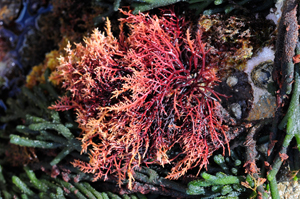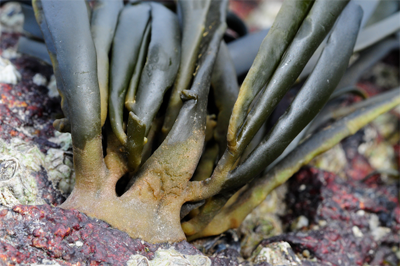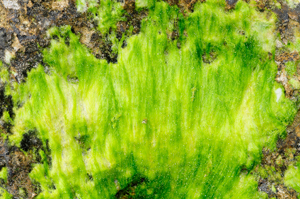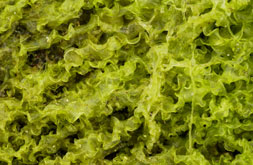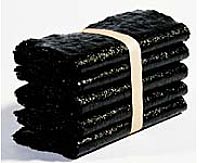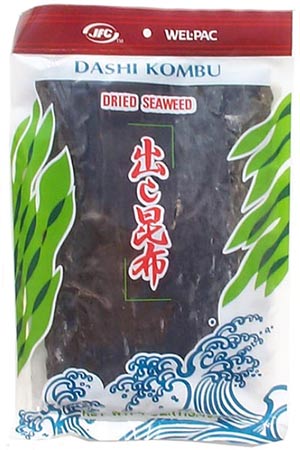THE NUTRITIONAL AND MEDICINAL VALUE OF SEAWEEDS
USED IN CHINESE MEDICINE
by Subhuti Dharmananda, Ph.D., Director, Institute for Traditional Medicine, Portland, Oregon
There are four seaweeds commonly used in Chinese medicine:
- Laminaria (kelp), a brown algae and Ecklonia (the more commonly used item), a green algae as sources of kunbu (Laminaria is sometimes called haidai, to distinguish it from Ecklonia or other sources)
- Sargassum, a brown algae, as the source of haizao
- Pyrphora, a red algae, as the source of zicai
These seaweeds will be discussed briefly in this article.
SEAWEED'S NUTRITIONAL VALUE (1)
Seaweed draws an extraordinary wealth of mineral
elements from the sea that can account for up to 36% of its dry mass.
The mineral macronutrients include sodium, calcium, magnesium,
potassium, chlorine, sulfur and phosphorus; the micronutrients include
iodine, iron, zinc, copper, selenium, molybdenum, fluoride, manganese,
boron, nickel and cobalt.
Seaweed has such a large proportion of iodine compared
to dietary minimum requirements, that it is primarily known as a source
of this nutrient. The highest iodine content is found in brown algae,
with dry kelp ranging from 1500-8000 ppm (parts per million) and dry
rockweed (Fucus) from 500-1000 ppm. In most instances, red and
green algae have lower contents, about 100-300 ppm in dried seaweeds,
but remain high in comparison to any land plants. Daily adult
requirements, currently recommended at 150 µg/day, could be covered by
very small quantities of seaweed. Just one gram of dried brown algae
provides from 500-8,000 µg of iodine and even the green and red algae
(such as the purple nori that is used in Japanese cuisine) provides
100-300 µg in a single gram.
The amounts of seaweed ingested as food in Japan, or in
supplements, is often considerably more than 1 gram a day. Studies show
that the human body adapts readily to higher iodine intake, where the
thyroid gland is the main tissue involved in use of iodine (it is a
component of thyroid hormones). Huge portions of the world population
get insufficient iodine because the land, plants, and animals that serve
as common dietary sources are very low in iodine. In many countries,
iodine is added to table salt to assure adequate levels are attained.
However, some developing countries are still catching up and suffering
from the effects of low iodine intake. China is has the largest
population with a history of low iodine intake, followed by India.
Aside from iodine, seaweed is one of the richest plant
sources of calcium, but its calcium content relative to dietary
requirements pales in comparison to the iodine. The calcium content of
seaweeds is typically about 4-7% of dry matter. At 7% calcium, one gram
of dried seaweed provides 70 mg of calcium, compared to a daily dietary
requirement of about 1,000 mg. Still, this is higher than a serving of
most non-milk based foods.
Protein content in seaweed varies somewhat. It is low in
brown algae at 5-11% of dry matter, but comparable in quantitative
terms to legumes at 30-40% of dry matter in some species of red algae.
Green algae, which are still not harvested much, also have a significant
protein content, i.e., up to 20% of dry matter. Spirulina, a
micro-alga, is well known for its very high content, i.e., 70% of dry
matter.
Seaweed contains several vitamins. Red and brown algae
are rich in carotenes (provitamin A) and are used, in fact, as a source
of natural mixed carotenes for dietary supplements. The content ranges
from 20-170 ppm. The vitamin C in red and brown algae is also notable,
with contents ranging from 500-3000 ppm. Other vitamins are also
present, including B12, which is not found in most land plants.
Seaweed has very little fat, ranging from 1-5% of
dry matter, although seaweed lipids have a higher proportion of
essential fatty acids than land plants. Green algae, whose fatty acid
make-up is the closest to higher plants, have a much higher oleic and
alpha-linoleic acid content. Red algae have a high EPA content, a
substance mostly found in animals, especially fish. Seaweed has a high
fiber content, making up 32% to 50% of dry matter. The soluble fiber
fraction accounts for 51-56% of total fibers in green (ulvans) and red
algae (agars, carrageenans and xylans) and for 67-87% in brown algae
(laminaria, fucus, and others). Soluble fibers are generally associated
with having cholesterol-lowering and hypoglycemic effects.
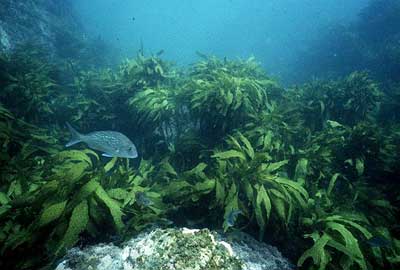
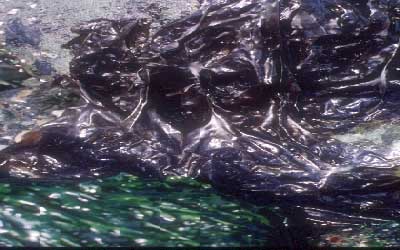
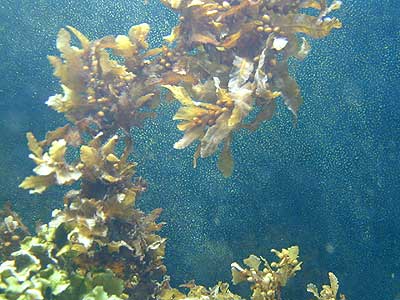
| 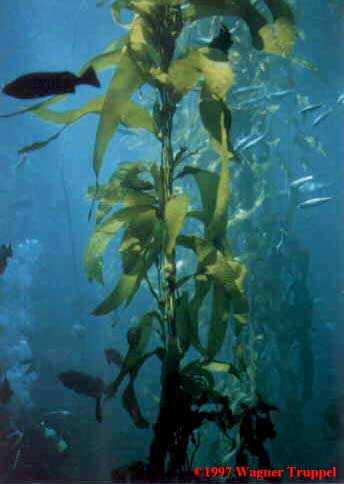
|
Seaweeds: Ecklonia (upper left); Porphyra (middle left);
Sargassum (lower left); Laminaria (right)
|
FOOD USES
Probably the most widely known seaweed used for food is Porphyra, which literally means purple (see sample leaf below), reflecting its color in nature. The Chinese name is zicai,
which means purple vegetable. It is classified among the red algae,
which have red to purple pigments. Upon processing to yield the food,
which is known in Japan as nori, the red pigments are lost and the final
product has a dark greenish color. Nori is used to wrap sushi and for
making numerous snacks. The other common food item is the low cost but
highly nutritious kelp (kunbu in Chinese; kombu in Japanese). Kombu is
usually sold in 5-6-inch dried pieces and can be found in health food
stores and Japanese groceries (see sample package below). It is also
sold as kombu that cooks quickly, vinegared, shaved kombu that needs
little or no cooking, boiled, soy sauce flavored kombu, lightly pickled
kombu, and powdered kombu that can be sprinkled on food or used in
drinks. Dried kombu needs to be simmered for at least 20 minutes to
soften it and flavor the liquid. If used only for flavoring stock, the
kombu itself is removed from the liquid at the end of cooking and
discarded. A third seaweed widely used in Japan is known as wakame
(from Undaria pinnatifida). See the Appendix for information about seaweed utilization in Japan.
MEDICINAL USES
Seaweeds have a salty taste that is an
indication that the material can disperse phlegm accumulation,
particularly as it forms soft masses, include goiter, the thyroid
swelling that indicates severe iodine deficiency. Following are the
descriptions of the seaweeds from Oriental Materia Medica (2):
Kunbu (Laminaria and Ecklonia)
- Essence and Flavor: Salty, Cold
- Channel Entered: Liver, Stomach, Kidney
- Actions: Softens hardness, disperses accumulation, resolves phlegm, cleanses heat
- Applications: Scrofula, goiter, tumor, edema, accumulation, testicular pain and swelling
Haizao (Sargassum)
- Essence and Flavor: Bitter, Salty, Cold
- Channel Entered: Liver, Stomach, Kidney
- Actions: Disperses accumulated phlegm, disperses goiter and tumor, delivers water, cleanses heat
- Applications: Scrofula, goiter, tumor, edema, testicular pain and swelling
Zicai (Porphyra)
- Essence and Flavor: Sweet, Salty, Cold
- Channel Entered: Lung
- Actions: Resolves phlegm, softens hardness, dispels heat, promotes diuresis
- Applications: Goiter, beriberi [leg swelling], edema, urinary infection, sore throat
The descriptions for kunbu and haizao are quite similar. Yang Yifan (3) wrote about the differences between these commonly used seaweeds:
Haizao and Kunbu are salty and cold, and
enter the liver, lung, and kidney meridians. Both can clear heat,
transform phlegm, soften hardness, and dissipate nodules. They can also
promote urination and reduce edema. In clinical practice, they are
often used together to treat nodules such as goiter and scrofula.
There are some differences between the two herbs. Haizao is stronger in transforming phlegm and dissipating nodules, and it is more suitable for treating goiter and scrofula. Kunbu is
stronger in softening hardness and reducing congealed blood; it is more
suitable for treating liver-spleen enlargement, liver cirrhosis, and
tumors.
One of the best known formulas with the seaweeds is Haizao Yuhu Tang,
or the Sargassum Decoction for the Jade Flask (4). This formula of 12
ingredients includes Sargassum, Ecklonia, and Laminaria. It was used to
treat a condition of goiter which was so severe it made the throat look
like a large flask. However, these seaweeds have been adopted into
formulas for treating other soft swellings, including ovarian cysts,
breast lumps, lymph node swellings, lipomas, and fat accumulation from
simple obesity.
REFERENCES
- Secretariat of the Pacific Community Coastal Fisheries Programme, Seaweed's nutritional value, Fisheries Information Newsletter #95, October-December 2000.
- Hsu HY, et al., Oriental Materia Medica: A Concise Guide, 1986 Oriental Healing Arts Institute, Long Beach, CA.
- Yang Yifang, Chinese Herbal Medicines: Comparisons and Characteristics, 2002 Churchill-Livingstone, London
- Bensky D and Barolet R, Chinese Herbal Medicine: Formulas and Strategies, 1990 rev. ed., Eastland Press, Seattle, WA.
APPENDIX: JAPAN AND SEAWEED
Following is an outline report on Japanese
utilization of seaweed and seaweed products, with data from 1998, except
as noted, thanks to the Fisheries Information Newsletter (1).
- Japan is the world's largest seafood producer, importer and
consumer. Annual seafood expenditures totaled 36,425 yen (~$300 U.S.)
per capita.
- Total fresh seaweed production was 623,286 tons for all types
of seaweed. But, this is far less than Japan uses for certain seaweeds,
particularly those used for industrial processing of specialty seaweed
products.
- Today, Japan is the leading importer of seaweed, while Korea is the premier exporter-with Japan as its main customer.
- Japanese imports stood at a total of 71,800 tons of fresh
seaweed produce valued at over $150 million dollars. It consisted of
40,900 tons of Undaria (a seaweed that grows in the Pacific, from
Korea to Japan to Australia) imported from China and Korea worth $65.3
million dollars, plus other varieties worth $38 million dollars.
- Exports of seaweed from Japan were 1214 tons of miscellaneous
seaweed, i.e., processable raw seaweed, dried kombu and nori worth $12
million dollars, plus 59 million dried Porphyra sheets (as used for making sushi) worth $4.6 million dollars. The exports are mainly sold to the USA and Taiwan.
- There are at least 21 seaweed species used daily in food
preparation in Japan. The Japanese consume an average of 4 kg per capita
every year (~11 grams per day). There is also a large industry built
around the three common colloid compounds derived from seaweed: agar,
alginate, and carrageenan. These are used to provide thickening and
texture to foods, and for other uses.
- The agar industry started in Japan over 400 years ago in
mountainous regions where, in cold winters, agar would set into a gel.
Japan now imports the raw material, the seaweeds Gracilaria and Gelidium, from Chile and South Africa, for a yearly output of 1000-1500 tons of agar in 1994.
- Alginate extraction in Japan is carried out using Ecklonia and Durvillea imported
from Chile and South Africa. The alginate obtained is high-quality
material and is used in specific biotech applications. The use of Laminaria spp.
for kombu, moreover, has resulted in the import of another raw material
so as to extract alginates. Overall production of alginate is about
1000-1500 tons per year (1994 figures).
- The carrageenan industry is mainly based on direct imports of
seaweeds (1,718 tons in 1994). Carragenophytes are also imported from
Southeast Asian aquafarms (yielding Eucheuma and Kappaphycus) and from wild stocks in North and South America and Europe (yielding Chondrus and Gigartina).
Seaweed Farming in Japan
Seaweed farming is highly developed in Japanese coastal areas. The main species grown there are Porphyra (nori), Laminaria (kombu) and Undaria (wakame).
These alone have accounted for 98% of overall Japanese seaweed
production since 1984. The balance is made up of minor traditional (Monostroma, Enteromorpha and Cladosiphon) or experimental (Meristotheca and Grateloupia) crops or wild stock harvests.
Nori
Nori is a traditional food used, for example, to make
sushi, which has been a highly profitable crop over the past century.
Since the reproduction cycle's summer phase was discovered by Dr
Kathleen Drew-Baker, farming has become easier and more lucrative - so
much so that no imports have occurred since 1976. Porphyra cultivation
is the largest sub-industry in Japanese aquafarming, employing 16,800
workers. In 1998, output stood at 10,326 million nori sheets, i.e.
equivalent to 396,615 tons of fresh produce.
Kombu
Kombu is the most widely sold seaweed in Japan. It is
an "all-purpose" product although it is most commonly used for
bean-curd soup with kombu.
Wild stock still accounts for a major share of output. Several species of the genus Laminaria are used in the Japanese food industry. Laminaria japonica takes the lion's share of kombu production with a raw-material tonnage of 141,875.
Wakame
Undaria pinnatifida cultivation is a
relatively recent development in Japan and wakame is served as a luxury
food on Japanese and Korean tables. It is highly sought after for
bean-curd soup or salads. Raw-material production, standing at 73,508
tons, is unable to meet Japanese demand for wakame.
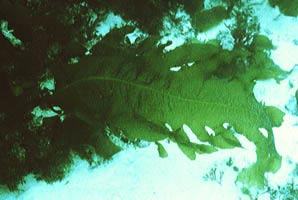
Undaria pinnatifida (wakame)
 Description: Spiralled Wrack, Fucus spiralis, is the uppermost species of Fucus that occurs on the shore. The frond lacks bladders (Fucus vesiculosus) and does not have a serrated edge (Fucus serratus); it is sometimes spiralled. This species has recently had another, common species segregated from it, Fucus guiryi. For characters to distinguish the two species, go to the description of this entity.
Description: Spiralled Wrack, Fucus spiralis, is the uppermost species of Fucus that occurs on the shore. The frond lacks bladders (Fucus vesiculosus) and does not have a serrated edge (Fucus serratus); it is sometimes spiralled. This species has recently had another, common species segregated from it, Fucus guiryi. For characters to distinguish the two species, go to the description of this entity.
 Description: Dichotmously branched fronds arising from
a small disc via a short stipe; distinct midrib. Plants to 300 mm with
terminal, compressed receptacles with warty conceptacles. This is the
"Serrated wrack" of the lower shore in the north-eastern Atlantic. It is
easily recognised by its saw-toothed frond, and a lack of swollen
receptacles (see below).
Description: Dichotmously branched fronds arising from
a small disc via a short stipe; distinct midrib. Plants to 300 mm with
terminal, compressed receptacles with warty conceptacles. This is the
"Serrated wrack" of the lower shore in the north-eastern Atlantic. It is
easily recognised by its saw-toothed frond, and a lack of swollen
receptacles (see below). 

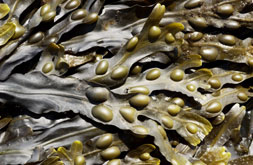 found in some species and these help to keep the plant afloat when submerged.
found in some species and these help to keep the plant afloat when submerged.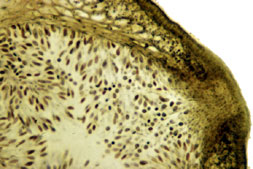 The
male reproductive structures (left, in section) are called
antheridiophores which are branched, tree-like structures that line the
conceptacles. The antheridiophores have terminal inflated antheridia on
their branches; these undergo meiosis and form 64-128 biflagellate male
gametes (antherozoids).
The
male reproductive structures (left, in section) are called
antheridiophores which are branched, tree-like structures that line the
conceptacles. The antheridiophores have terminal inflated antheridia on
their branches; these undergo meiosis and form 64-128 biflagellate male
gametes (antherozoids).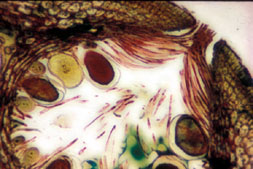 causes
dessication and the gametes are squeezed onto the surface of the
receptacle, and are then washed off and mixed by the inoming tide. The
female egg liberates a volatile hydrocarbon, fucoserraten (a compound
with 8 carbon atoms) which attracts the male antherozoids; these cluster
around the egg and spin it; one penetrates the complex series of coats
around the egg and karyogamy (nuclear fusion) occurs. The zygotic cell
settles down and germinates to form a new diploid thallus. Strictly
speaking, the so-called gametophyte thallus in Fucus is a
sporophyte that undergoes meiosis just before gametes are formed. This
is the reason why some textbooks refer to the male gametangia as
'microsporangia' and the female gametangia as 'megasporangia'. Fucus
species are found in the upper, mid, and lower intertidal in the colder
waters of the northern Atlantic and northern Pacific. The genus is
absent from the southern hemisphere.
causes
dessication and the gametes are squeezed onto the surface of the
receptacle, and are then washed off and mixed by the inoming tide. The
female egg liberates a volatile hydrocarbon, fucoserraten (a compound
with 8 carbon atoms) which attracts the male antherozoids; these cluster
around the egg and spin it; one penetrates the complex series of coats
around the egg and karyogamy (nuclear fusion) occurs. The zygotic cell
settles down and germinates to form a new diploid thallus. Strictly
speaking, the so-called gametophyte thallus in Fucus is a
sporophyte that undergoes meiosis just before gametes are formed. This
is the reason why some textbooks refer to the male gametangia as
'microsporangia' and the female gametangia as 'megasporangia'. Fucus
species are found in the upper, mid, and lower intertidal in the colder
waters of the northern Atlantic and northern Pacific. The genus is
absent from the southern hemisphere.
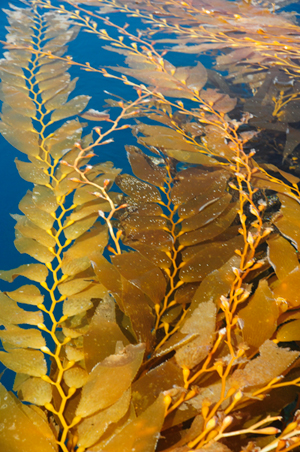
 Most
brown algae have an alternation of haploid and diploid generations. The
haploid thalli form isogamous, anisogamous or oogamous gametes and the
diploid thalli form zoospores, generally by meiosis. The haploid
(gametangial) and diploid (sporangial) thalli may be similar
(isomorphic) or different (heteromorphic) in appearance, or the
gametangial generation may be extremely reduced (Fucales). The brown
Giant Kelp Macrocystis pyrifera
(top) is harvested off the coasts of California for feeding abalone.
It used to be used for alginate extraction, but this now mostly comes
from Atlantic Ascophyllum nodosum and Laminaria hyperborea. Alginates,
derivatives of alginic acids, are used commercially for toothpastes,
soaps, ice cream, tinned meats, fabric printing, and a host of other
applications. It forms a stable viscous gel in water, and its primary
function in the above applications is as a binder, stabilizer,
emulsifier, or moulding agent. Saccharina japonica, formerly Laminaria, and other species of the genus are grown on ropes in China, Korea and Japan for food and alginate production. Undaria pinnatifida is
also cultivated in Japan, Korea and China for production of Wakame, a
valuable food kelp. Small amounts are also grown in Atlantic France for
the European market.
Most
brown algae have an alternation of haploid and diploid generations. The
haploid thalli form isogamous, anisogamous or oogamous gametes and the
diploid thalli form zoospores, generally by meiosis. The haploid
(gametangial) and diploid (sporangial) thalli may be similar
(isomorphic) or different (heteromorphic) in appearance, or the
gametangial generation may be extremely reduced (Fucales). The brown
Giant Kelp Macrocystis pyrifera
(top) is harvested off the coasts of California for feeding abalone.
It used to be used for alginate extraction, but this now mostly comes
from Atlantic Ascophyllum nodosum and Laminaria hyperborea. Alginates,
derivatives of alginic acids, are used commercially for toothpastes,
soaps, ice cream, tinned meats, fabric printing, and a host of other
applications. It forms a stable viscous gel in water, and its primary
function in the above applications is as a binder, stabilizer,
emulsifier, or moulding agent. Saccharina japonica, formerly Laminaria, and other species of the genus are grown on ropes in China, Korea and Japan for food and alginate production. Undaria pinnatifida is
also cultivated in Japan, Korea and China for production of Wakame, a
valuable food kelp. Small amounts are also grown in Atlantic France for
the European market.
 Marine macroalgae, or seaweeds, are plant-like organisms that generally live attached to rock or other hard substrata in coastal areas. They belong to three different groups, empirically distinguished since the mid-nineteenth century on the basis of thallus color: brown algae (phylum Orchrophyta, class Phaeophyceae; see right for a large brown kelp, Durvillaea in New Zealand), red algae (phylum Rhodophyta; below Gelidium in Ireland), and green algae (phylum Chlorophyta, classes Bryopsidophyceae, Chlorophyceae, Dasycladophyceae, Prasinophyceae, and Ulvophyceae; bottom, Ulva howensis in Lord Howe Island off eastern Australia). Distinguishing these three phyla, however, involves more substantial differences than colour. In addition to the pigmentation, they differ considerably in many ultrastructural and biochemical features including photosynthetic pigments, storage compounds, composition of cell walls,presence / absence of flagella, ultrastructure of mitosis, connections between adjacent cells, and the fine structure of the chloroplasts. They originated through different evolutionary processes (primary endosymbiosis for green and red algae, secondary endosymbiosis for brown algae, and for this reason they are now classified in different kingdoms (green algae and red algae in the Kingdom Plantae, and brown algae in the Kingdom Chromista).
Marine macroalgae, or seaweeds, are plant-like organisms that generally live attached to rock or other hard substrata in coastal areas. They belong to three different groups, empirically distinguished since the mid-nineteenth century on the basis of thallus color: brown algae (phylum Orchrophyta, class Phaeophyceae; see right for a large brown kelp, Durvillaea in New Zealand), red algae (phylum Rhodophyta; below Gelidium in Ireland), and green algae (phylum Chlorophyta, classes Bryopsidophyceae, Chlorophyceae, Dasycladophyceae, Prasinophyceae, and Ulvophyceae; bottom, Ulva howensis in Lord Howe Island off eastern Australia). Distinguishing these three phyla, however, involves more substantial differences than colour. In addition to the pigmentation, they differ considerably in many ultrastructural and biochemical features including photosynthetic pigments, storage compounds, composition of cell walls,presence / absence of flagella, ultrastructure of mitosis, connections between adjacent cells, and the fine structure of the chloroplasts. They originated through different evolutionary processes (primary endosymbiosis for green and red algae, secondary endosymbiosis for brown algae, and for this reason they are now classified in different kingdoms (green algae and red algae in the Kingdom Plantae, and brown algae in the Kingdom Chromista).